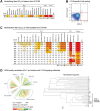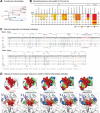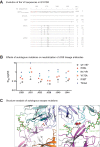Development of Neutralization Breadth against Diverse HIV-1 by Increasing Ab-Ag Interface on V2
- PMID: 35319830
- PMCID: PMC9130890
- DOI: 10.1002/advs.202200063
Development of Neutralization Breadth against Diverse HIV-1 by Increasing Ab-Ag Interface on V2
Abstract
Understanding maturation pathways of broadly neutralizing antibodies (bnAbs) against HIV-1 can be highly informative for HIV-1 vaccine development. A lineage of J038 bnAbs is now obtained from a long-term SHIV-infected macaque. J038 neutralizes 54% of global circulating HIV-1 strains. Its binding induces a unique "up" conformation for one of the V2 loops in the trimeric envelope glycoprotein and is heavily dependent on glycan, which provides nearly half of the binding surface. Their unmutated common ancestor neutralizes the autologous virus. Continuous maturation enhances neutralization potency and breadth of J038 lineage antibodies via expanding antibody-Env contact areas surrounding the core region contacted by germline-encoded residues. Developmental details and recognition features of J038 lineage antibodies revealed here provide a new pathway for elicitation and maturation of V2-targeting bnAbs.
Keywords: antibody evolution; broadly neutralizing antibodies; humoral immunity; nonhuman primates; simian/human immunodeficiency virus; virus variation.
© 2022 The Authors. Advanced Science published by Wiley-VCH GmbH.
Conflict of interest statement
The authors declare no conflict of interest.
Figures






References
-
- UNAIDS , UNAIDS Fact‐sheet 2020. https://www.unaids.org/en/resources/fact-sheet (accessed: September, 2021).
-
- Rerks‐Ngarm S., Pitisuttithum P., Nitayaphan S., Kaewkungwal J., Chiu J., Paris R., Premsri N., Namwat C., de Souza M., Adams E., Benenson M., Gurunathan S., Tartaglia J., McNeil J. G., Francis D. P., Stablein D., Birx D. L., Chunsuttiwat S., Khamboonruang C., Thongcharoen P., Robb M. L., Michael N. L., Kunasol P., Kim J. H., Investigators M.‐T., N. Engl. J. Med. 2009, 361, 2209. - PubMed
-
- Gray G. E., Bekker L. G., Laher F., Malahleha M., Allen M., Moodie Z., Grunenberg N., Huang Y., Grove D., Prigmore B., Kee J. J., Benkeser D., Hural J., Innes C., Lazarus E., Meintjes G., Naicker N., Kalonji D., Nchabeleng M., Sebe M., Singh N., Kotze P., Kassim S., Dubula T., Naicker V., Brumskine W., Ncayiya C. N., Ward A. M., Garrett N., Kistnasami G., et al., N. Engl. J. Med. 2021, 384, 1089. - PubMed
-
- Malim M. H., Emerman M., Cell 2001, 104, 469. - PubMed
Publication types
MeSH terms
Substances
Grants and funding
- 2021YFC2301500/National Key Research and Development Program of China
- National Institute of Allergy and Infectious Diseases
- 82002138/National Natural Science Foundation of China
- 31970888/National Natural Science Foundation of China
- 2017TD-05/Program for JLU Science and Technology Innovative Research Team
- P01 AI131251/AI/NIAID NIH HHS/United States
- 2018ZX10731101-002-003/Key Projects in the National Science & Technology Pillar Program in the Thirteenth Five-year Plan Period
- 2018ZX10731101-001-010/Key Projects in the National Science & Technology Pillar Program in the Thirteenth Five-year Plan Period
- HSSN261200800001E/National Cancer Institute's National Cryo-EM Facility at the Frederick National Laboratory for Cancer Research
- Intramural Research Program of the Vaccine Research Center
LinkOut - more resources
Full Text Sources
Medical
